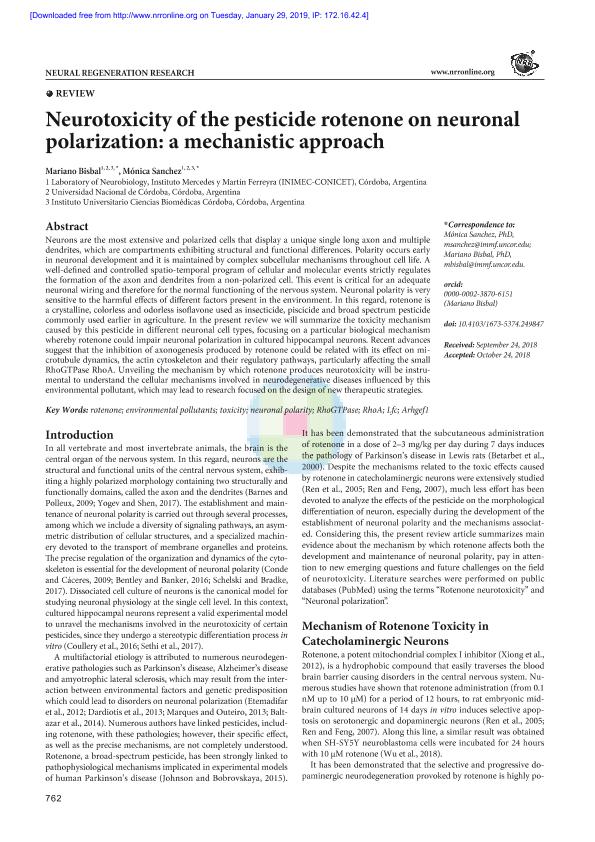Mostrar el registro sencillo del ítem
dc.contributor.author
Bisbal, Mariano

dc.contributor.author
Sanchez, Monica Silvina

dc.date.available
2021-03-24T15:03:51Z
dc.date.issued
2019-05
dc.identifier.citation
Bisbal, Mariano; Sanchez, Monica Silvina; Neurotoxicity of the pesticide rotenone on neuronal polarization: A mechanistic approach; Shenyang Editorial Dept Neural Regeneration Res; Neural Regeneration Research; 14; 5; 5-2019; 762-766
dc.identifier.issn
1673-5374
dc.identifier.uri
http://hdl.handle.net/11336/128867
dc.description.abstract
Neurons are the most extensive and polarized cells that display a unique single long axon and multiple dendrites, which are compartments exhibiting structural and functional differences. Polarity occurs early in neuronal development and it is maintained by complex subcellular mechanisms throughout cell life. A well-defined and controlled spatio-temporal program of cellular and molecular events strictly regulates the formation of the axon and dendrites from a non-polarized cell. This event is critical for an adequate neuronal wiring and therefore for the normal functioning of the nervous system. Neuronal polarity is very sensitive to the harmful effects of different factors present in the environment. In this regard, rotenone is a crystalline, colorless and odorless isoflavone used as insecticide, piscicide and broad spectrum pesticide commonly used earlier in agriculture. In the present review we will summarize the toxicity mechanism caused by this pesticide in different neuronal cell types, focusing on a particular biological mechanism whereby rotenone could impair neuronal polarization in cultured hippocampal neurons. Recent advances suggest that the inhibition of axonogenesis produced by rotenone could be related with its effect on microtubule dynamics, the actin cytoskeleton and their regulatory pathways, particularly affecting the small RhoGTPase RhoA. Unveiling the mechanism by which rotenone produces neurotoxicity will be instrumental to understand the cellular mechanisms involved in neurodegenerative diseases influenced by this environmental pollutant, which may lead to research focused on the design of new therapeutic strategies.
dc.format
application/pdf
dc.language.iso
eng
dc.publisher
Shenyang Editorial Dept Neural Regeneration Res

dc.rights
info:eu-repo/semantics/openAccess
dc.rights.uri
https://creativecommons.org/licenses/by-nc-sa/2.5/ar/
dc.subject
ARHGEF1
dc.subject
ENVIRONMENTAL POLLUTANTS
dc.subject
LFC
dc.subject
NEURONAL POLARITY
dc.subject
RHOA
dc.subject
RHOGTPASE
dc.subject
ROTENONE
dc.subject
TOXICITY
dc.subject.classification
Biología Celular, Microbiología

dc.subject.classification
Ciencias Biológicas

dc.subject.classification
CIENCIAS NATURALES Y EXACTAS

dc.title
Neurotoxicity of the pesticide rotenone on neuronal polarization: A mechanistic approach
dc.type
info:eu-repo/semantics/article
dc.type
info:ar-repo/semantics/artículo
dc.type
info:eu-repo/semantics/publishedVersion
dc.date.updated
2020-11-19T21:16:36Z
dc.identifier.eissn
1876-7958
dc.journal.volume
14
dc.journal.number
5
dc.journal.pagination
762-766
dc.journal.pais
China

dc.description.fil
Fil: Bisbal, Mariano. Consejo Nacional de Investigaciones Científicas y Técnicas. Centro Científico Tecnológico Conicet - Córdoba. Instituto de Investigación Médica Mercedes y Martín Ferreyra. Universidad Nacional de Córdoba. Instituto de Investigación Médica Mercedes y Martín Ferreyra; Argentina
dc.description.fil
Fil: Sanchez, Monica Silvina. Consejo Nacional de Investigaciones Científicas y Técnicas. Centro Científico Tecnológico Conicet - Córdoba. Instituto de Investigación Médica Mercedes y Martín Ferreyra. Universidad Nacional de Córdoba. Instituto de Investigación Médica Mercedes y Martín Ferreyra; Argentina
dc.journal.title
Neural Regeneration Research

dc.relation.alternativeid
info:eu-repo/semantics/altIdentifier/doi/http://dx.doi.org/10.4103/1673-5374.249847
dc.relation.alternativeid
info:eu-repo/semantics/altIdentifier/url/https://www.ncbi.nlm.nih.gov/pmc/articles/PMC6375050/
Archivos asociados
